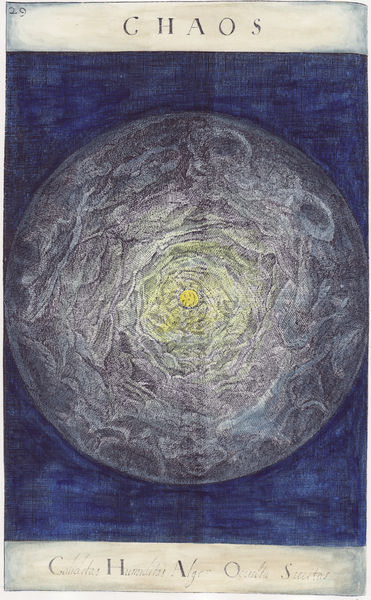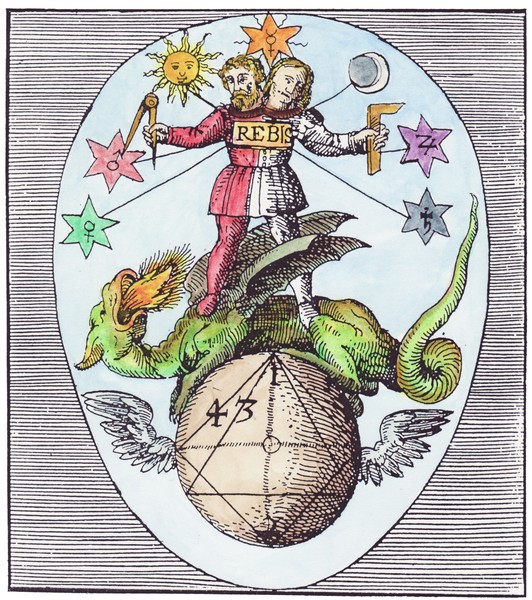
The Book of Lambspring, Musaeum Hermeticum, Frankfurt 1625. © Adam McLean 1997-2017 (alchemywebsite.com). Used with permission.
The Sages say truly
That two animals are in this forest:
One glorious, beautiful, and swift,
A great and strong deer;
The other an unicorn.
[..]
He that knows how to tame and master them by Art,
To couple them together,
And to lead them in and out of the forest,
May justly be called a Master.
For we rightly judge
That he has attained the golden flesh,
And may triumph everywhere;
Nay, he may bear rule over great Augustus.
The Book Of Lambspring
To anyone paying attention, it should be obvious that the inverted moral value (vice) of infidelity that is actively and very profitably promoted in the half light of public consciousness, in adultery-themed “dating” sites, apps, and “reality” TV, is now being actively normalised by mainstream media, along with ‘liberal’ academia.

This “normalisation” of cheating has exactly the same root as the accounting, banking, and money systems.
As we have seen recently, the first step in an alchemical experiment is called nigredo (“blackening”; a synonym for corruption, decay, sacrifice, death, negation).
In double entry bookkeeping, the foundation of the accounting, banking, and money systems, the first rule is also an act of negation:
For every debit there must be an equal credit, and for every credit there must be an equal debit.
In Cabala, the first act of creation by “Ein-Sof” (Infinite God) is said to be an act of self-negation (“tzimtzum”; contraction, concealment).
In mainstream “financial intermediation” theory of banking, the first principle is a pretence of self-negation: supposedly, the mere coupling together of two opposites, Savers and Borrowers.
This “normalisation” of cheating – a direct attack on the cornerstone social bonds of traditional marriage and family – aims to bring about the corruption – and destruction – of human society.
Or, as the “philosophers” of the “royal Art” prefer to frame it, the “transformation” of human society.
The first step in the “experiment”, is the decay, destruction, or negation, of traditional moral values. Only then can the alchemist bring forth “gold” from the “base”; the “higher”, from the “lower”; Order, out of Chaos.
“I hate purity, I hate goodness! I don’t want virtue to exist anywhere. I want everyone to be corrupt to the bones.”
“You will be hollow. We shall squeeze you empty, and then we shall fill you with ourselves.”
1984

Barent Coenders van Helpen, L’Escalier des Sages (“The Stairs of the Wise”), Cologne, 1693. © Adam McLean 1997-2017 (alchemywebsite.com). Used with permission.
Cui bono? (to whose benefit?)
The money-lenders.
Or, as I have taken to saying, the Usurocracy*.
It should not be necessary to spell out the myriad economic impacts of broken marriages, and broken homes, inclining “preferences” toward an increased “demand” (need) for debt: the Usurocracy’s exclusive monopoly “product”.
One can only wonder at the magnitude of economic inefficiencies – and wealth inequality – associated with the increased “need” to pay billions in fees to the “family” lawyer class, for example.
I would like to draw public attention to the alchemical symbolism evidencing this once covert, and now increasingly overt goal, of normalising infidelity – that is to say, lying and cheating.
In previous essays we have seen that the ancient “Art” of alchemy is an andocentric, misogynous, predatory sex magic system, whose hidden goal is the theft, manipulation, and domination, of the feminine birth-force (life, “growth”) energy, or “gynergy”.
For power and profit.
Throughout recorded history, alchemical adepts have advanced their deception by combining exoteric (outer) and esoteric (inner) doctrines, with the difference between the two cloaked in metaphor, allegory and symbolism – in particular, by means of the rebus (Latin rēbus “by means of objects”) or punning principle – thus hiding the truth in plain sight:
The Rebis (from Latin res bina, meaning dual or double matter) is the end product of the alchemical magnum opus or great work.

Heinrich Nollius, Theoria Philosophiae Hermeticae, 1617. © Adam McLean 1997-2017 (alchemywebsite.com). Used with permission.
As we have also seen, the alchemical “Art” is based on two philosophical principles: the Unity of Opposites (exoteric), and the Law of Inversion (esoteric).
The “profane” are gulled – enchanted – by the outward appearance of beauty, nobility and virtue. Only the “illuminated” understand that the appearance cloaks a diabolic inner doctrine of inversion, that is explicitly contra naturam.
To illustrate this, let us now consider the alchemical allegory of the Stag and the Unicorn, from the Book of [Abraham] Lambspring (Frankfurt, 1625):
It seems that this little book was first published under the title De Lapide Philosophico Triga Chemicum (Prague 1599) compiled by the Frenchman Nicolas Barnaud prominent in the alchemical circles around Rudolf II.
Appearing at face value to be a work of “spiritual” alchemy, “[i]ts verses point to the soul and spirit involved in the alchemical transformation and its fifteen emblems are evocative symbols of these inner processes.”
The parable of the “deer” and the Unicorn appears to explain that the forest is “the Body”, the deer is “the Soul” , and the unicorn “the Spirit”. Knowing how to master all three “by Art” appears to be the goal aspired to.
The tinctures in alchemy relate also to the substances of the Mass, the red wine, the blood, and the white wafer, the body of Christ. Administration of the Sacraments was seen as spiritualising the souls of the partakers. In alchemical terms these white and red stones or tinctures served much the same purpose, though the alchemists achieved this, not through the intermediacy of a priest but by their own inner work of transmutation. Here alchemy links directly with the Grail stories which use similar parallels between the Grail and the Sacraments. The red tincture was occasionally symbolised by a stag bearing antlers. The stag being seen as a noble masculine animal. This links in with the Unicorn as a symbol of the white or feminine tincture. In some alchemical illustrations, such as that of the late 16th century Book of Lambspring, the Stag and Unicorn meet in the forest of the soul as part of the process of inner transformation.
We have already learned, however, that the secret inner doctrine of alchemy is one of sexual magic, and that the inversion (or reversal) of values lies at its heart.

J.D. Mylius, Rosary of the Philosophers (Rosarium philosophorum sive pretiosissimum donum Dei), 1622. © Adam McLean 1997-2017 (alchemywebsite.com). Used with permission.
The Stag as a symbol is often associated with the Sun [Sola ☉, Mars ♂, Asset, active, creditor] and the Unicorn is usually linked with the Moon [Luna ☽, Venus ♀, Liability, passive, debtor]. These polarities are to be coupled together through the alchemist’s work.
Seen in this hidden ‘light’ – from the “other side” of the Sun or “Black Sun” – the parable of the Stag and the Unicorn is actually a metaphor for the infidelity and promiscuity (Latin infidēlitas: unfaithful, disloyal, treacherous) that is essential to the alchemists’ sex magic rituals; where, in the act of “coupl[ing] them together”, the initiated adept uses a cunning trick (upaya, method) to steal the seed of the woman for his own empowerment, and enrichment:
He that knows how to tame and master them by Art,
To couple them together,
And to lead them in and out of the forest,
May justly be called a Master.
Rather than the “deer” representing nobility of the Soul, for the alchemical adept it represents the rutting Stag’s “active” (creditor) sexual activity with all the females (debtor) in the herd.
stag (n.)
late 12c., probably from Old English stagga “a stag,” from Proto-Germanic *stag-, from PIE root *stegh- “to stick, prick, sting.” The Old Norse equivalent was used of male foxes, tomcats, and dragons; and the Germanic root word perhaps originally meant “male animal in its prime.”
Adjectival meaning “pertaining to or composed of males only” (as in stag party) is American English slang from 1848. Compare bull-dance, slang for one performed by men only (1845); gander (n.) also was used in the same sense. Stag film “pornographic movie” is attested from 1968. Stag beetle, so called for its “horns,” is from 1680s.
Rather than the Unicorn representing the Spirit, for the initiated it represents a cynical mockery of what is to him a mythical creature – the chaste and faithful female; symbolic also of the Holy Spirit, the Wisdom of God, the Virgin Mary, and the Christian saint.
Herodotus, a Greek historian who lived c. 490 to 425 BC, wrote that “the foulest Babylonian custom” was the practice of sacred prostitution. Once in their lifetimes, all women were required to sit in the temple of Ishtar/Inanna (“Aphrodite” to the greek Herodotus) and “have intercourse with some stranger” in return for money which was given to the temple:
Once a woman has taken her place there, she does not go away to her home before some stranger has cast money into her lap, and had intercourse with her outside the temple; but while he casts the money, he must say, “I invite you in the name of Mylitta” (that is the Assyrian name for Aphrodite). It does not matter what sum the money is; the woman will never refuse, for that would be a sin, the money being by this act made sacred. So she follows the first man who casts it and rejects no one. [..] So then the women that are fair and tall are soon free to depart, but the uncomely have long to wait because they cannot fulfill the law; for some of them remain for three years, or four.
It is noteworthy that “a fraction of female gender researchers” dispute Herodotus’ account, claiming that the entire notion began with a few “patriarchal” Greek writers concocting defamatory tales about cultural or political enemies.
What is of importance is that the existence of “holy prostitution” in Babylon has been the widely-held belief, for thousands of years. Given this accepted milieu then, it is little wonder that the adepts of “Hermes, the Sage, the Babylonian” are seen in alchemical texts referring to the “base” subjects of their experiments as “whores”, and in at least one instance, as “the Babylonian whore”.
The final four verses of the parable clearly allude to what is the true goal of the alchemist: the attainment of “golden flesh”, that he may “triumph everywhere” and “rule over great Augustus” (the first Roman emperor).
As we saw in Cheating Females: The Production Of Inequality, By Illusions of Equality, the “gold” sought by the alchemists is threefold:
[T]he “Alchemy of life: he can make his life last as long as the sun and moon[; the] Alchemy of body: he can make his body eternally be but sixteen years old[; and the] Alchemy of enjoyments: he can turn iron and copper into gold”. These three experiments, then, primarily concern two goals: firstly the attainment of immortality, and secondly the production of gold, that is, material wealth.
I would draw your attention to two further points of special interest, before leaving you to contemplate the entire parable for yourself.
Firstly, bear in mind that the exoteric (public) doctrine actively promotes the idea of “equality” of the two “universal” genders. Then observe the subtle, egocentric misogyny implied by the lyrical praise of the Male (“glorious, beautiful and swift”, “great and strong”, etc), sharply contrasted by the absence of any adjectives, much less any superlatives, applied to the Female. One might get the impression (“The other an unicorn”) that the Female is merely an afterthought, barely worth mentioning at all.
Secondly, observe that the Stag is depicted as proudly boasting six (6) tines on each of its antlers, and bear in mind that a stag’s antlers function as objects of sexual attraction, and as weapons in fights for control over harems.
The Book of Lambspring,
A Noble Ancient Philosopher,
Concerning the Philosophical Stone;
Rendered into Latin Verse by
Nicholas Barnaud Delphinas,
Doctor of Medicine, a zealous Student of this Art.
Figure III
HEAR WITHOUT TERROR THAT IN THE FOREST ARE HIDDEN A DEER AND AN UNICORN
The Sages say truly
That two animals are in this forest:
One glorious, beautiful, and swift,
A great and strong deer;
The other an unicorn.
They are concealed in the forest,
But happy shall that man be called
Who shall snare and capture them.
The Masters shew you here clearly
That in all places
These two animals wander about in forests
(But know that the forest is but one).
If we apply the parable to our Art,
We shall call the forest the Body.
That will be rightly and truly said.
The unicorn will be the Spirit at all times.
The deer desires no other name
But that of the Soul; which name no man shall take away from it.
He that knows how to tame and master them by Art,
To couple them together,
And to lead them in and out of the forest,
May justly be called a Master.
For we rightly judge
That he has attained the golden flesh,
And may triumph everywhere;
Nay, he may bear rule over great Augustus.
For further reading on the topic of sexual “freedom”, I can recommend E. Michael Jones’ Libido Dominandi: Sexual Liberation and Political Control:
“Thus, a good man, though a slave, is free; but a wicked man, though a king, is a slave. For he serves, not one man alone, but, what is worse, as many masters as he has vices.”
– St. Augustine, City of God
Writing at the time of the collapse of the Roman Empire, St. Augustine both revolutionized and brought to a close antiquity’s idea of freedom. A man was not a slave by nature or by law, as Aristotle claimed. His freedom was a function of his moral state. A man had as many masters as he had vices. This insight would provide the basis for the most sophisticated form of social control known to man.
Fourteen hundred years later, a decadent French aristocrat turned that tradition on its head when he wrote that “the freest of people are they who are most friendly to murder.” Like St. Augustine, the Marquis de Sade would agree that freedom was a function of morals. Unlike St. Augustine, Sade proposed a revolution in sexual morals to accompany the political revolution then taking place in France. Libido Dominandi – the term is taken from Book I of Augustine’s City of God – is the definitive history of that sexual revolution, from 1773 to the present.
Unlike the standard version of the sexual revolution, Libido Dominandi shows how sexual liberation was from its inception a form of control. Those who wished to liberate man from the moral order needed to impose social controls as soon as they succeeded because liberated libido led inevitably to anarchy. Aldous Huxley wrote in his preface to the 1946 edition of Brave New World that “as political and economic freedom diminishes, sexual freedom tends compensatingly to increase.” This book is about the converse of that statement. It explains how the rhetoric of sexual freedom was used to engineer a system of covert political and social control. Over the course of the two-hundred-year span covered by this book, the development of technologies of communication, reproduction, and psychic control – including psychotherapy, behaviorism, advertising, sensitivity training, pornography, and plain old blackmail – allowed the Enlightenment and its heirs to turn Augustine’s insight on its head and create masters out of men’s vices. Libido Dominandi is the story of how that happened.
*******
Ye have heard that it was said by them of old time, Thou shalt not commit adultery:
But I say unto you, That whosoever looketh on a woman to lust after her hath committed adultery with her already in his heart.
– Jesus of Nazareth (Sermon on the Mount; Matthew 5:27-28)
*******
* Credit for the term “Usurocracy” goes to Dr John Dunn, author of Renaissance: Counter Renaissance
REFERENCES
Abraham Lambspring, The Book of Lambspring, Nicholas Barnaud Delphinas Ed.
Adam McLean, A Threefold Journey Through The Book Of Lambspring
Adam McLean, Animal Symbolism In Alchemy
Herodotus, The Histories (1.199), A.D. Godley Ed., Cambridge. Harvard University Press. 1920
V. and V. Trimondi, The Shadow of the Dalai Lama: Sexuality, Magic and Politics in Tibetan Buddhism (2003), transl. by Mark Penny


I have found your website to be very informative, putting into words many things I have intuited but have been unable to communicate so clearly. One thing I found perplexing was your saying “did you see what I did” in one of your posts. When you are trying to elucidate the deceptions practiced by charlatans it seems to me to be counterproductive,to say the least,to practice those deceptions and then not expose them.l have drawn the logical conclusion from this and leave you to enjoy your motorcycle.
Thanks for your comment. There appears to be a misunderstanding. The “Did you see what I did then?” question is posed to draw the reader’s closer attention to the wording of the prior sentence. I then provide a clear hint, with link, in the immediately following sentence (“Lo0k again.”) If you look carefully, you see that that second “o” in “Lo0k” is the symbol theta, and has a link to its explanation. There is no deception – the point of this is to promote readers to carefully observe the way in which words are used to convey (potentially) multiple meanings. In that example, the subtle reference is to the preceding sentence “..with positive and negative numbers *added*”. In other words (eg), +1 added to -1 = 0. I hope this helps.
There is a similar use of the identical prompt in Part 2 that essay.